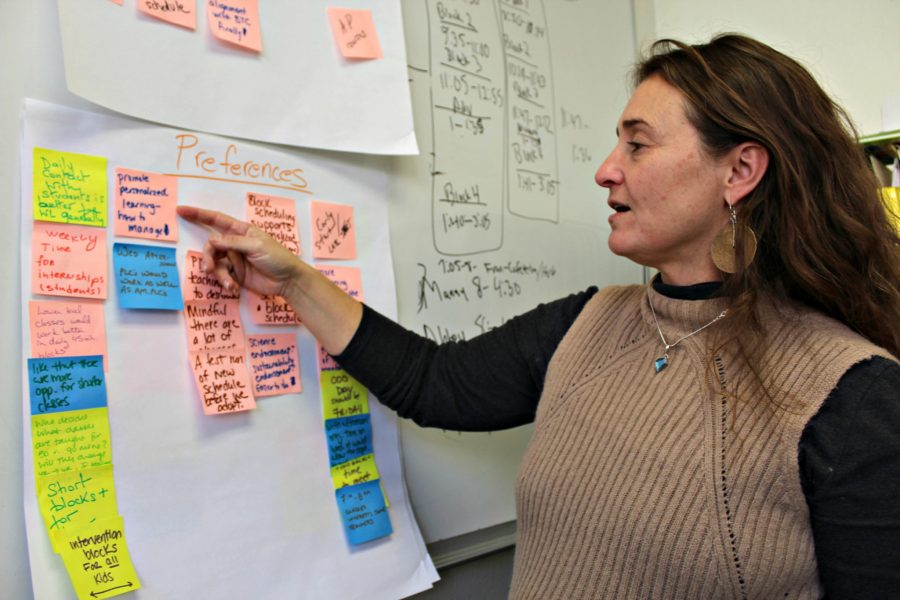BHS Principal Tracy Racicot started the school year with a big problem to tackle: scheduling. Only a few months into the job, she is hard at work figuring out a solution.
“What we really want to do is have a schedule that aligns with our core values and mission, and that is flexible pathways to learning,” Racicot said.
She has been in the process of gathering information from students, parents and teachers, with the goal of having a draft or structure in place by mid-December. The wall of Racicot’s office is covered in sticky notes with suggestions from faculty members.
She cited scheduling issues, lack of study halls, large class sizes, and the fact that instructional blocks are all the same length, all as areas for improvement.
“Brain research often shows that math and other language-based instruction often work best when there is daily contact in smaller chunks,” Racicot said.
Student feedback has been solicited through advisories with facilitated discussions, and a survey will be released later this week. Racicot also paid a visit to the “School Innovation Seminar” class taught by Dov Stucker, which focuses on school redesign. She took part in a student consultancy along with the administrative team.
Much of the discussion has been around two concept or model schedules. One option includes a mix of class duration, with shorter length blocks for courses like math, music and foreign languages, and longer blocks for science, english, history, art. The shorter blocks would meet daily while the longer blocks would meet every other day.
Math teacher Jim Park thinks that shorter blocks would be beneficial in his subject area.
“Students need shorter blocks to learn,” he said. “Our brain only focuses in 20 minute increments.”
Park had eight classes each day while in high school, which worked well for him.
His math department colleague, Chaim Lodish, is skeptical of the change. He believes it would benefit some lower level classes, yet negatively affect advanced courses.
“Could you do the same in two 45 minute classes that you can do in 90?” he said. “The answer is probably not.”

The other model that has been a point of discussion offers no call back, reduced advisory time, and a “flex block” for teachers, student groups and clubs to meet. This would take place in the middle of the school day.
Racicot would not say what ideas the administrative team was leaning towards, but indicated that the final schedule may likely be a hybrid of two of the concepts. She is also open to changing the start and end times of school.
The CDC reports that the average high school start time is 8:03, however the American Academy of Pediatrics recommends high schools should start no earlier than 8:30 am. According to the National Sleep Foundation, increased sleep means reduced chance of experiencing depression, improved attendance and timeliness, and reduced accidents caused by drowsy driving. In addition, insufficient sleep during one’s high school years can lead to long term health problems. The CDC confirms that sleep deprived adolescents are more likely to be overweight, engage in smoking, drinking, drugs, and illicit activities.
The high school currently begins classes at 8:05 except for Wednesdays, when classes begin at 8:50 due to teacher meetings.
Sleep deprivation is a chronic health problem among adolescents in the United States. Experts have determined adolescents need 8-10 hours of sleep each night, however most students will agree they don’t get close to that amount. Less than one third of high school students sleep 8 hours per night, according to the Centers for Disease Control and Prevention (CDC).
Racicot is considering having some classes with varying start times. Altering the schedule in that manner would have contractual issues, something she doesn’t see as a major obstacle.
“I firmly believe that the BEA is looking for the best interests of our students,” she said. “If a schedule that is a bit more flexible better meets the needs of the students I think they’ll be on board.”
Going forward, the “non-negotiables” on Racicot’s list include keeping advisory, aligning with the Burlington Technical Center schedule, protecting teacher prep and planning time, incorporating dual enrollment, AP classes and adding some 45 minute blocks.
Building an effective schedule won’t be easy, especially following several years of budget reductions.
“We don’t expect that additional dollars will flow from the taxpayers to support restoring staff, so we really need to find innovative ways to make do with what we have,” Racicot said. “It’s a huge challenge, but we embrace that challenge to make sure that flexible pathways are available for students to learn.”
Limited Honors Classes
Aliyah Burr walked into her honors history class on the first day of school and discovered that that there was nowhere to sit. Ten minutes later she was asked to leave.
“I was pretty upset for a while, as was my mom,” she said.
An increasing number of students are experiencing the aftermath of budget cuts and reduced course offerings. Class sizes are maxed-out and scheduling is like solving the gordian knot. More students that seats was a frequent sight at the start of the school year.

Burr, a sophomore, had signed up for honors level history and english classes at the start of the year. After leaving her history course, she spent over 90 minutes in the guidance office. The department created a new section for her and several peers, but she was unable to stay at the same english level.
“This was where I wanted to be, this was the material I wanted to be studying,” she said. “The fact that I wasn’t able to was really upsetting.”
Burr said she was told that her schedule was the easiest to change. She hopes to do something over the summer to make up for her inability to take an honors level English course.
No Math?
Willa Govoni expected she would spend the start of her school year tackling equations and parabolas. Instead she faced a different type of problem: trying to get a math class.
Govoni began her first day of school by following her schedule and walking to Algebra II, where she was asked to leave. That then began a two week struggle of trying to find a spot in a class. Large class sizes had left the options thin.
The junior met with the BHS administrative team, Principal Tracy Racicot and math department teachers. She was told that she could audit a course, taking it without a grade. The teacher of that course made an exception when she came to the class. After her long struggle, Govoni now has a math class, a subject area which requires three credits to graduate.

Her first two weeks of pushing for a math course left her stressed out and upset.
“They made question my academic future,” she said. “I was pretty depressed.”
The addition of the math class turned Govoni’s schedule upside down. Four of her classes were affected, including chorus, one of her favorite classes.
“I understand that scheduling is a big issue for a school of our size,” Govoni said. “But the toll that it takes on students is huge.”








